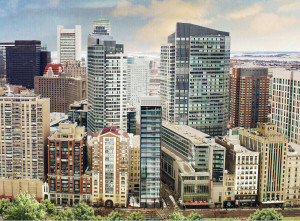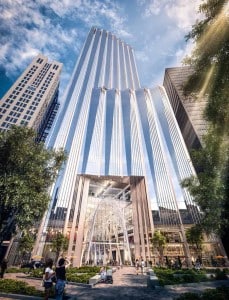
The doomed skinny tower was first envisioned as a 31-story, 355-foot-tall building; after two shaves it was down to 13 stories and 155 feet. Depicted in this rendering is version two at 19 stories.
The demise of Boston’s first “skinny tower” highlights anew an ironclad rule of development in the Hub: Unless you are well-connected power player about town, forget about trying to build anything.
A loaded Swiss development family – whose patriarch’s private life has been tabloid fodder at times – has thrown in the towel on its vision of a pencil-thin tower overlooking Boston Common.
Maurice Dabbah and his globetrotting real estate family have pocketed a check for $24 million from Emerson College for the old and unspectacular 5-story Tremont Street building the developer had hoped to bulldoze to make way for a Big Apple-style, super-thin luxury high-rise.
The deal ended up being sweet anyway for the Swiss investor; after all, he paid only $16.4 million for it.
But while Dabbah may have made a 50 percent return, the truth is his plan to add a little color to the Boston skyline with its first skinny tower never had a fair chance of becoming reality.
The question is not who was against the project but rather who wasn’t. In an epic Boston pig pile, everyone jumped on, from elderly affordable housing tenants next door to activists worked up over shadows on public parks.
The city’s shadow police, the Friends of the Public Garden, led the charge, arguing the tower would violate a state law regulating how much shade can be thrown onto the iconic Boston park. But it’s hard to imagine the ill-fated skinny tower would have blocked much sun.
In its final form the proposed tower was just 13 stories high and a svelte 50 feet across. Dabbah first proposed a 31-story tower in 2015, only to later slash that down to 19 stories and then finally 13 in a muddled and frankly hopeless attempt to win over critics.
If the shadow concerns were foolish, complaints from would-be neighbors about traffic were simply ludicrous. The final proposal was for 12 condos – yes, 12! – one for each floor with a lobby on the street level, hardly the makings of a traffic jam unless you live in the Berkshires, not downtown Boston.
Millennium Nabs The Shadow Bank

Millennium Partners’ tower in Winthrop Square will go forward at 700 feet tall rather than the originally proposed 725 feet; the trim alleviates concerns about flight paths in and out of Logan Airport.
The final nail in the coffin for the skinny tower is the deal City Hall recently struck with Millennium Partners, paving the way for its 700-foot office and condo tower in the heart of the Financial District in Winthrop Square. The anti-shadow crowd went nutty over that tower proposal as well, despite the fact it is a quarter mile away from the Common.
In a bid to placate opponents, Mayor Marty Walsh agreed to limit the height of new development near the Common in exchange for letting Millennium’s new tower plan move forward.
It’s a deal that will pay dividends to Millennium, one of the city’s top builders with long-standing clout at City Hall that goes back to the late Mayor Tom Menino’s early years in charge. Millennium gets more than just its new Winthrop Square tower; the deal effectively knee-caps the Swiss developer’s proposed tower, as well as two other potential skinny tower rivals that might compete with its new Millennium Tower in Downtown Crossing or its older Ritz-Carlton Towers just off the Common.
When the big boys and girls are able to block out the competition, everyone loses.
There’s no disputing Boston’s success in attracting billions upon billions in new development over past few decades. But all these new towers and buildings aren’t bowling anybody over when it comes to innovative design and architecture. There’s an almost a build by the numbers, generic, institutional feel to many of newest additions to the Hub’s skyline. So it’s not much of a stretch to ask whether this blandness might be one result of having a handful of big developers dominate the Boston market for the last two or three decades.
Nor is the demise of the skinny tower likely to prove to be anything beyond a temporary victory for activists seeking to keep shadows off the Common. Emerson spent $24 million for an old 5-story building. That’s a lot of dough, given Dabbah bought it for $16 million and needed to build something substantial in order to make the investment pay. It’s no secret Emerson needs to build more dorm space, and maybe they can squeeze it into five stories, but I doubt it.
Letting some new players in isn’t a cure-all for Boston’s boring architecture. But it would at least mix thing up a bit so it’s not the same old players building everything.




 |
| 


